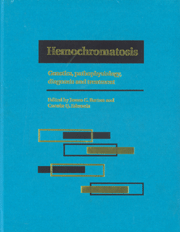Book contents
- Frontmatter
- Contents
- List of contributors
- Foreword
- Part I Introduction to hemochromatosis
- Part II Genetics of hemochromatosis
- Part III Metal absorption and metabolism in hemochromatosis
- Part IV Diagnostic techniques for iron overload
- Part V Complications of iron overload
- 21 Mechanisms of iron toxicity
- 22 Iron as a carcinogen
- 23 Clinical spectrum of hepatic disease in hemochromatosis
- 24 The arthropathy of hemochromatosis
- 25 Diabetes mellitus and hemochromatosis
- 26 Non-diabetic endocrinopathy in hemochromatosis
- 27 Cutaneous manifestations of hemochromatosis
- 28 Cardiac abnormalities in hemochromatosis
- 29 Estimate of the frequency of morbid complications of hemochromatosis
- 30 Juvenile hemochromatosis
- Part VI Therapy of hemochromatosis and iron overload
- Part VII Infections and immunity in hemochromatosis
- Part VIII Hemochromatosis heterozygotes
- Part IX Relationship of hemochromatosis to other disorders
- Part X Animal models of hemochromatosis and iron overload
- Part XI Screening for hemochromatosis
- Part XII Hemochromatosis: societal and ethical issues
- Part XIII Final issues
- Index
29 - Estimate of the frequency of morbid complications of hemochromatosis
from Part V - Complications of iron overload
Published online by Cambridge University Press: 05 August 2011
- Frontmatter
- Contents
- List of contributors
- Foreword
- Part I Introduction to hemochromatosis
- Part II Genetics of hemochromatosis
- Part III Metal absorption and metabolism in hemochromatosis
- Part IV Diagnostic techniques for iron overload
- Part V Complications of iron overload
- 21 Mechanisms of iron toxicity
- 22 Iron as a carcinogen
- 23 Clinical spectrum of hepatic disease in hemochromatosis
- 24 The arthropathy of hemochromatosis
- 25 Diabetes mellitus and hemochromatosis
- 26 Non-diabetic endocrinopathy in hemochromatosis
- 27 Cutaneous manifestations of hemochromatosis
- 28 Cardiac abnormalities in hemochromatosis
- 29 Estimate of the frequency of morbid complications of hemochromatosis
- 30 Juvenile hemochromatosis
- Part VI Therapy of hemochromatosis and iron overload
- Part VII Infections and immunity in hemochromatosis
- Part VIII Hemochromatosis heterozygotes
- Part IX Relationship of hemochromatosis to other disorders
- Part X Animal models of hemochromatosis and iron overload
- Part XI Screening for hemochromatosis
- Part XII Hemochromatosis: societal and ethical issues
- Part XIII Final issues
- Index
Summary
Introduction
There are many descriptions of the organ damage associated with late-stage hemochromatosis. The frequency of some of the symptoms of illness, abnormal physical examination findings and laboratory abnormalities in hemochromatosis patients who were identified in different ways are summarized in Table 29.1. The purpose of this chapter is to compare the morbidity of hemochromatosis in homozygotes who were not identified due to illness and in probands who were identified due to illness.
Selection bias in identification of hemochromatosis homozygotes
There is a strong ascertainment bias in the identification of hemochromatosis probands. The ascertainment of probands who seek medical attention due to illness is biased for the presence of morbidity. Those who are found to have hemochromatosis only because they participated in a screening study have an ascertainment bias for good health. A comparison of differences in the morbidity among groups of probands whose ascertainment was biased either for illness or for good health appears in Tables 29.2 and 29.3. The great differences in the morbidity among groups of sick probands and probands who were identified during screening clearly demonstrate the effect of ascertainment bias on the presentation of hemochromatosis.
The diagnosis of hemochromatosis is established much more frequently among men than in women. This also represents an ascertainment bias explained, in part, by differences in the amount of iron that accumulates in male and in female homozygotes. Male homozygotes, as a group, have a greater body iron burden than female homozygotes. Normal women may lose 10–15 grams of iron during their lifetime due to menstruation and pregnancies.
- Type
- Chapter
- Information
- HemochromatosisGenetics, Pathophysiology, Diagnosis and Treatment, pp. 312 - 317Publisher: Cambridge University PressPrint publication year: 2000
- 1
- Cited by



